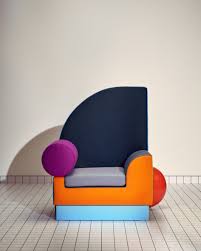Memphis Design is an influential postmodern style that emerged from the celebrated Memphis Design collective of Milan-based designers in the early 1980s. It was spearheaded by legendary Italian designer Ettore Sottsass (1917-2007), and had an outsize impact on 80s design.
With its bold colors, clashing patterns, and radical approach to design, Memphis Design was a polarizing style. Today Memphis Design is the stuff of museum retrospectives and a source of inspiration for modern-day designers.
Sottsass and his cohorts designed decorative metal and glass objects, home accessories, ceramics, lighting, textiles, furniture, buildings, interiors, and brand identities that were unexpected, playful, rule-breaking, and full of the idealistic desire to make the world a better place.
“When I was young, all we ever heard about was functionalism, functionalism, functionalism,” Sottsass once said. “It’s not enough. Design should also be sensual and exciting.”3
Memphis Design influenced the popular culture, inspiring TV shows like Pee–wee’s Playhouse and Saved By the Bell. Celebrity 1980s superfans of the design style included legendary fashion designer Karl Lagerfeld and David Bowie.
But this influential movement was short-lived, disbanding in 1988. In 1996, the Memphis-Milano brand was purchased by Alberto Bianchi Albrici, who continues to produce the collective’s original 1980s designs.
Is Memphis Design Style Making a Comeback?
As nostalgia for 80s style has returned, Memphis Design has become the stuff of museum retrospectives and a wellspring of inspiration for multi-disciplinary designers. This includes fashion houses such as Christian Dior and Missoni, and new generations of interior designers, type designers, costume designers, and more, such as London-based French multidisciplinary designer Camille Walala.

Key Characteristics of Memphis Design
- Challenged notions of conventional good taste
- Flouted the prevailing Bauhaus design philosophy that form follows function
- Designed to provoke an emotional response
- Loud, brash, spirited, playful, uninhibited
- Use of bright colors in unorthodox combinations
- Deliberate use of bold, clashing patterns
- Use of simple geometric shapes
- Use of black-and-white graphics
- Rounded edges and curves
- A fondness for squiggles
- Use of materials such as terrazzo and plastic laminate in various finishes
- Defying expectations by using unusual shapes in place of conventional ones, such as round legs on a table
What is the most famous Memphis Design item?
The most famous Memphis Design item is the Carlton room divider or bookcase. Designed by the movement’s founder Italian architect Ettore Sottsass in 1981, the luxury piece features multi-colored shapes made from inexpensive MDF and plastic laminate.
Why did Memphis Design end?
Memphis Design was never everybody’s cup of tea. The movement had fizzled before the 1980s were out, with founder Sottsass leaving the collective in 1985 and some of its other leading designers pursuing solo careers once the band broke up for good in 1988.
What is unique about Memphis Design?
Memphis Design embraced a radical mix of bold colors, clashing patterns, and a fearless mishmash of styles that made it unlike anything that had come before or has come along since.
